Wood bathroom vanities are enjoying a renaissance in 2025, prized for their warmth, sustainability, and ability to straddle almost any décor style. From weightless wall-mounted silhouettes to character-packed vintage upcycles, designers are using timber in ever more inventive ways to anchor the bath space. The following twenty ideas, each tightly focused on a specific design, show how different wood tones, textures, and construction tricks can solve storage problems, add personality, and boost resale value—all while standing up to humidity when properly sealed.
1. Floating Reclaimed Wood Bathroom Vanity
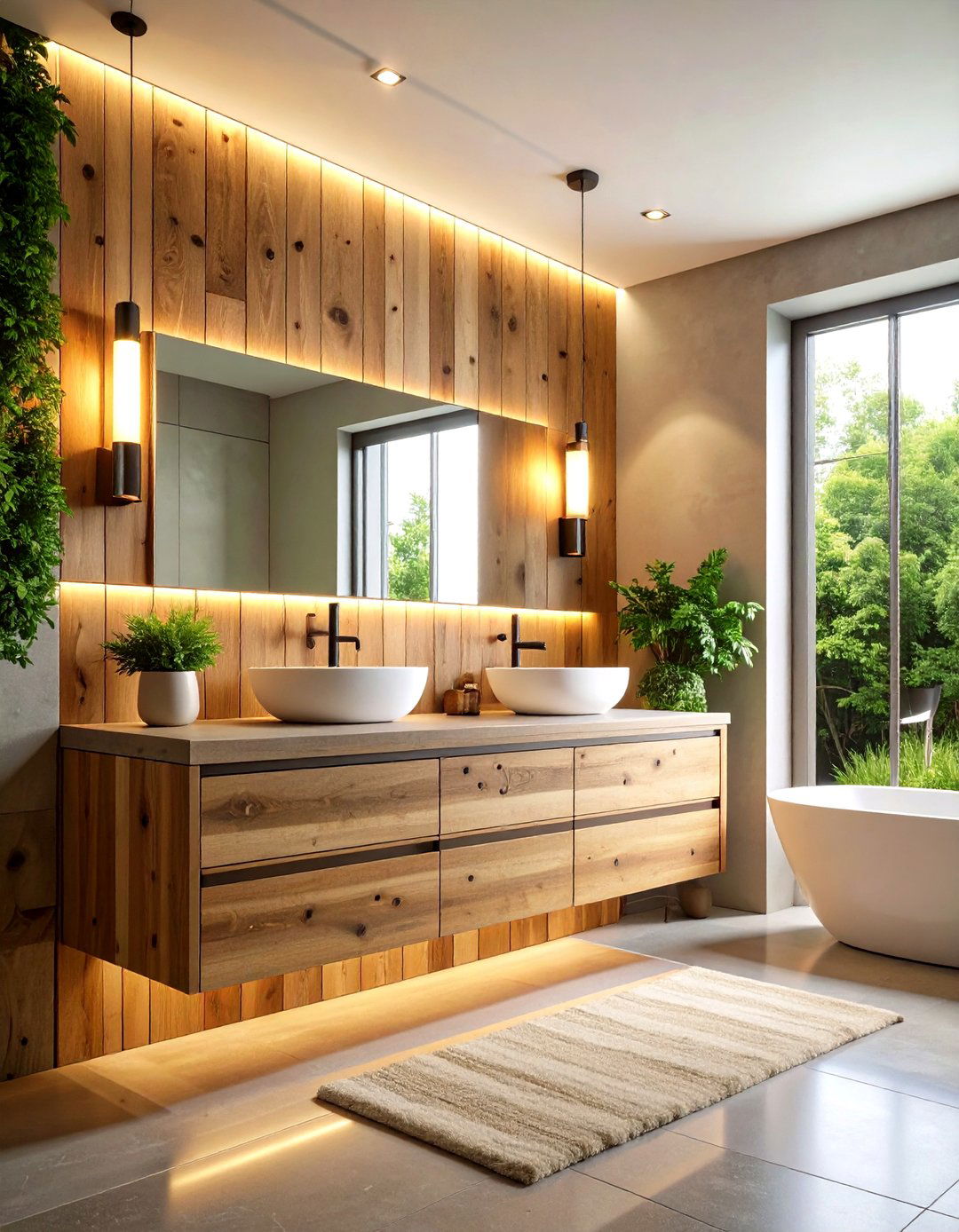
To create the illusion of a larger floorplate, a floating reclaimed wood bathroom vanity mounts directly to the studs, leaving the tile uninterrupted beneath. Designers love pairing it with under-cabinet LEDs, which cast a hotel-spa glow while doubling as a helpful night-light. Reclaimed oak or pine boards bring authentic nail holes and saw marks that new lumber lacks, injecting instant character and preventing the look from feeling too slick. Because the timber was salvaged, the vanity also ticks the sustainability box highlighted in 2025 trend reports, provided you seal every surface with marine-grade varnish to protect against splashes.
2. Live-Edge Slab Wood Bathroom Vanity
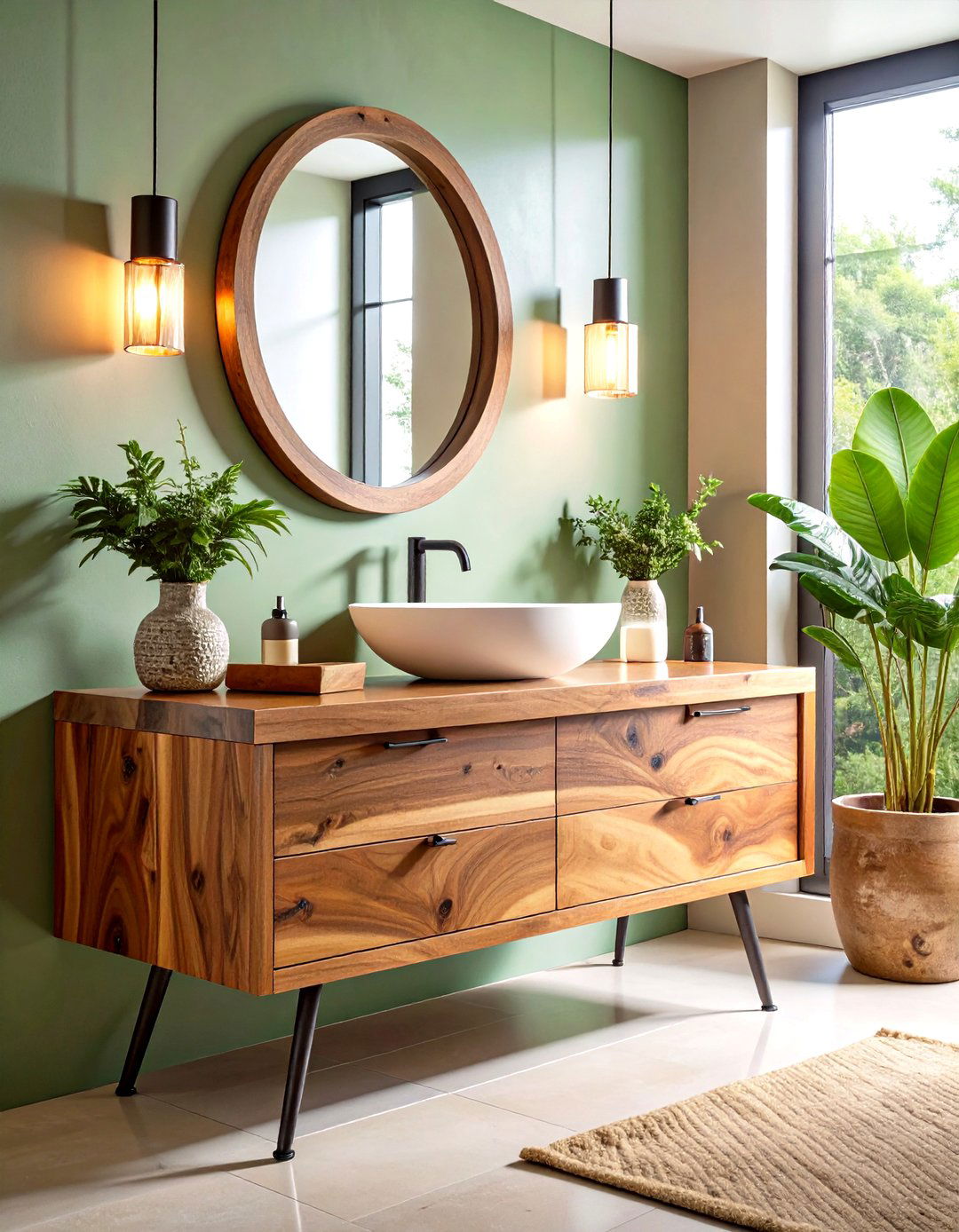
Unlike machine-edged cabinetry, a live-edge slab wood bathroom vanity keeps the bark-line intact, celebrating the tree’s original profile and adding organic drama to a modern bath. A thick walnut or acacia slab is usually mounted on steel brackets or hairpin legs, leaving room underneath for baskets and toe-kick lighting. Apply a clear penetrating epoxy to stabilize knots, then finish with a matte waterproof oil so the grain glows without feeling plasticky. Designers often offset the rugged top with an ultra-minimal vessel sink made from stone or concrete, ensuring the vanity remains the tactile star of the room.
3. Mid-Century Walnut Wood Bathroom Vanity

For fans of clean lines, try a mid-century walnut wood bathroom vanity with slim tapered legs, recessed pulls, and book-matched grain that flows over the drawer fronts. The period look is subtle enough to mix with contemporary fixtures yet instantly signals vintage pedigree when paired with a round frameless mirror and cone sconces. Soft-close glides and today’s moisture-resistant plywood boxes hide behind that rich chocolate veneer, so you gain 1960s style without 1960s maintenance headaches. Many makers top the case with white quartz or porcelain for easy wiping, giving the vanity a crisp color contrast that brightens cramped rooms.
4. Rustic Barn-Door Wood Bathroom Vanity
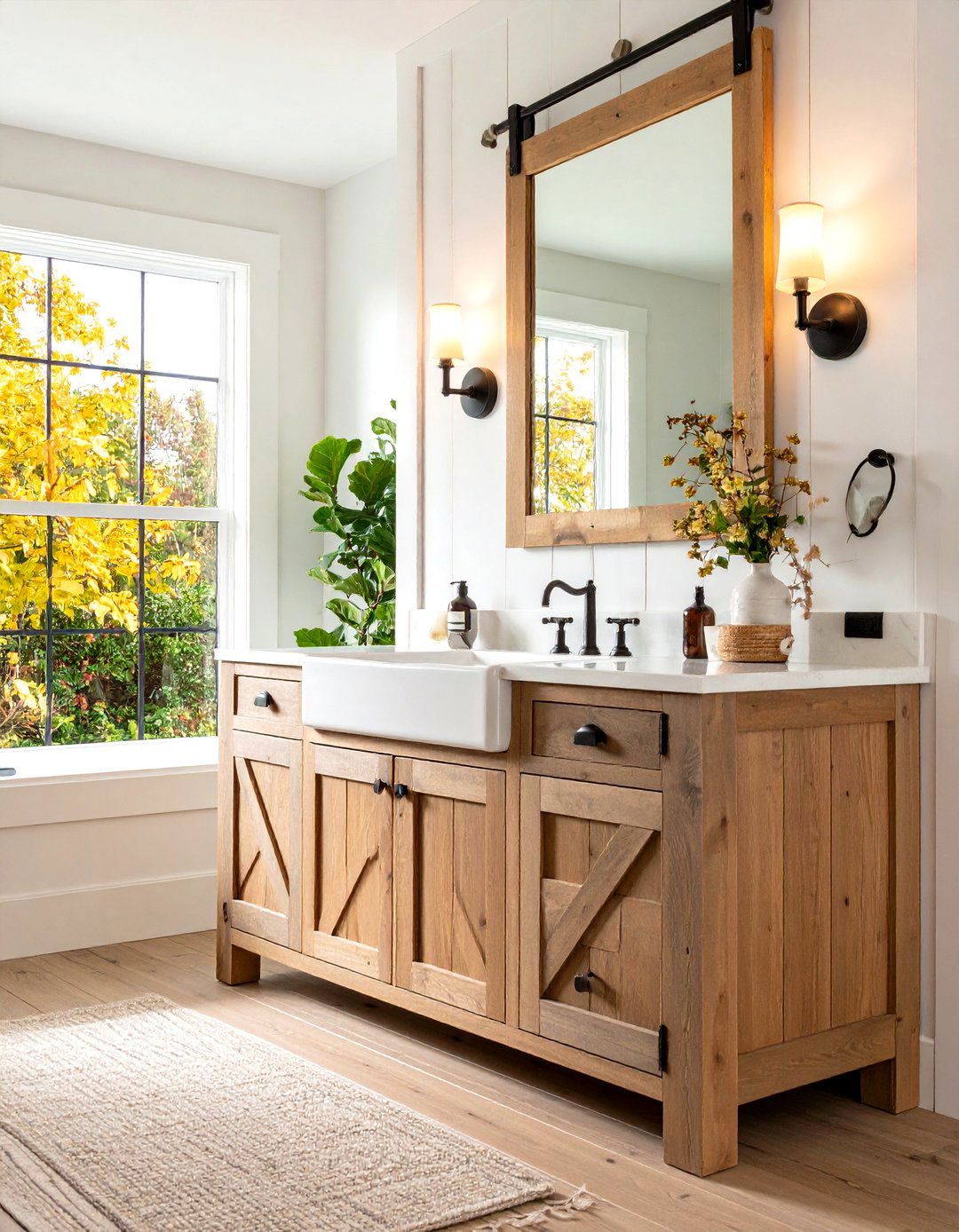
Surprisingly simple to build, a rustic barn-door wood bathroom vanity swaps traditional hinged fronts for sliding Z-brace doors on matte-black tracks, a nod to farmhouse pantry cabinets. The overlapping planks conceal deep shelves for extra towels while letting you slide one side open without blocking the walkway—handy in narrow ensuites. Distressing the pine with wire brushes and adding iron cup pulls exaggerates the weathered feel, yet a crisp porcelain apron sink and sleek faucet prevent the scheme from tipping into cliché. Homeowners on Pinterest save this mash-up more than any other vanity style, underscoring its broad appeal.
5. Scandinavian Oak Wood Bathroom Vanity
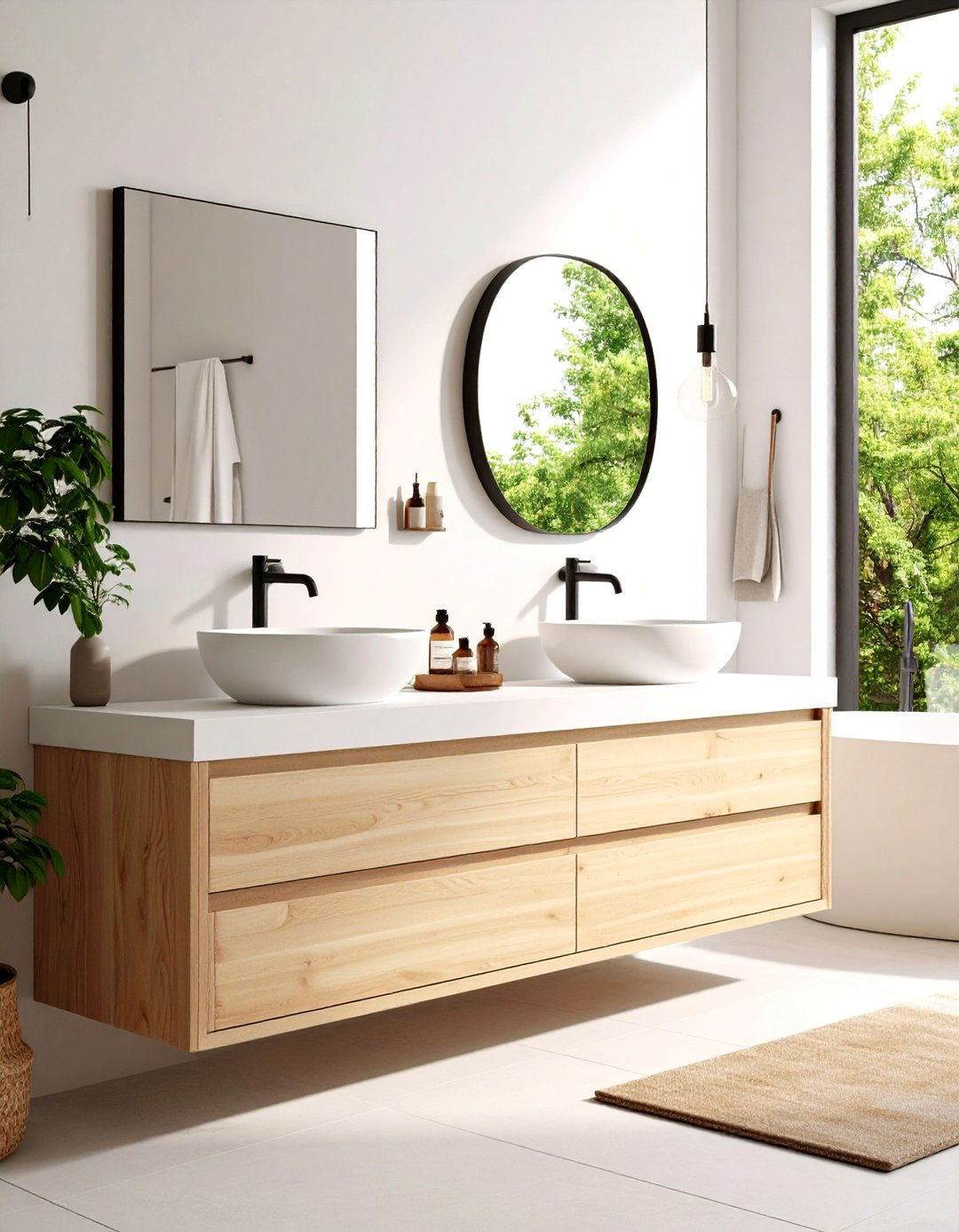
Looking for calm? A Scandinavian oak wood bathroom vanity combines pale, straight-grained timber with seamless finger-pull drawers and integrated toe-kicks to achieve that coveted “floating box” look. Designers favor natural hard-wax oils that preserve the creamy tone while providing water resistance, steering clear of orange-tinged lacquers. Slim, wall-wide drawer boxes hide power outlets for hair tools, eliminating countertop clutter and reinforcing the minimal ethos. Pair the vanity with a thin framed medicine mirror and matte-black tapware to echo Nordic restraint without feeling sterile. Slimline brass legs can further lighten the silhouette while protecting the oak from wet mops.
6. Industrial Pipe-Leg Wood Bathroom Vanity
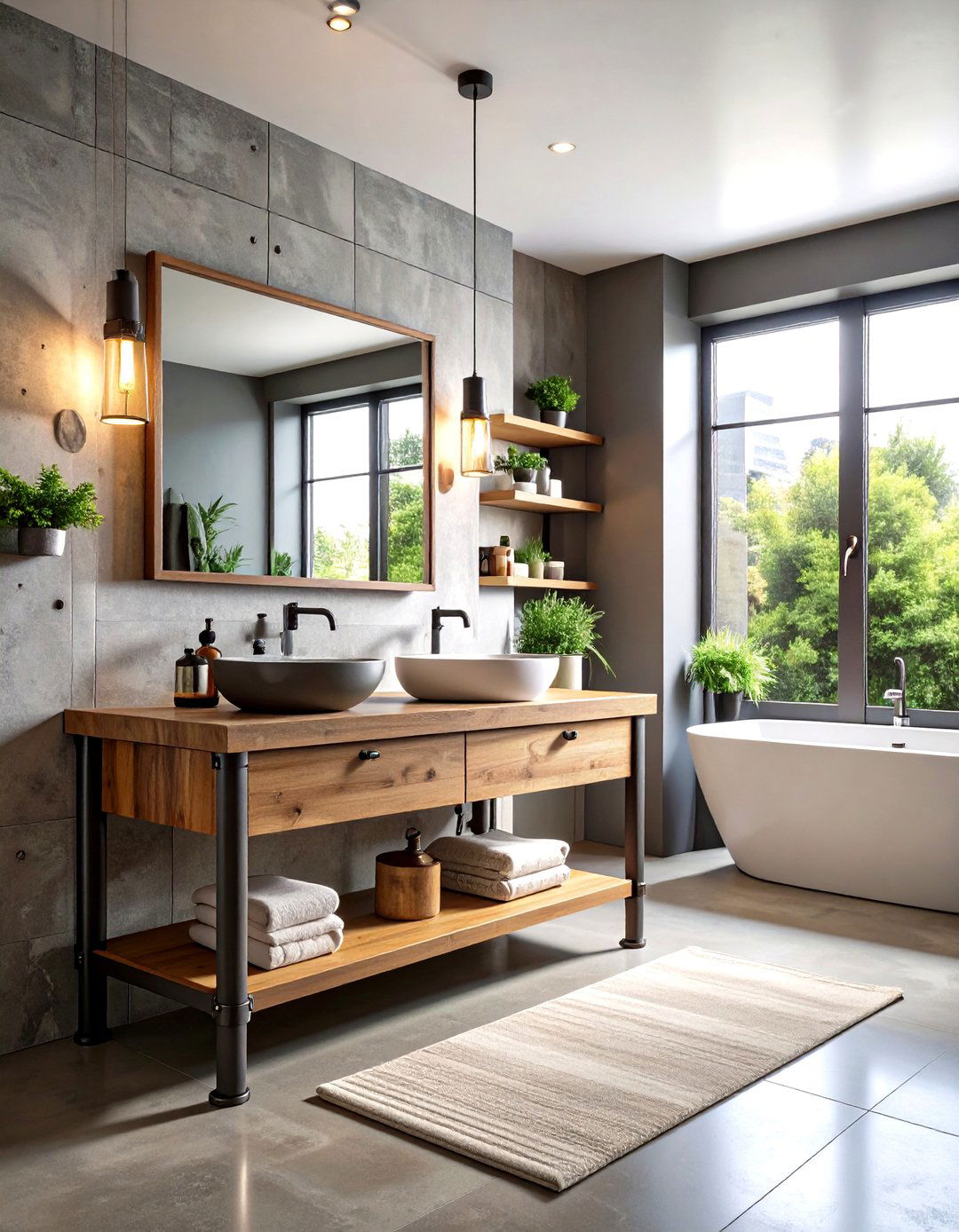
By contrast, an industrial pipe-leg wood bathroom vanity leans into mixed-material dynamism: matte-black iron plumber’s pipe supports a sanded butcher-block top, leaving bolt heads proudly exposed. The look marries well with brushed-steel cross-handles and concrete floor tile, delivering the kind of urban-loft attitude loft-dwellers crave. A single open shelf welded between the legs keeps spare rolls off the floor yet maintains the airy sight line that makes small baths feel bigger. Because the structure is entirely bolt-together, weekend renovators can assemble it on-site without specialty joinery tools—just remember clear polyurethane on all wood faces for damp protection. Swap the slab for a concrete trough sink to push the workshop aesthetic even further.
7. Farmhouse Shiplap Wood Bathroom Vanity
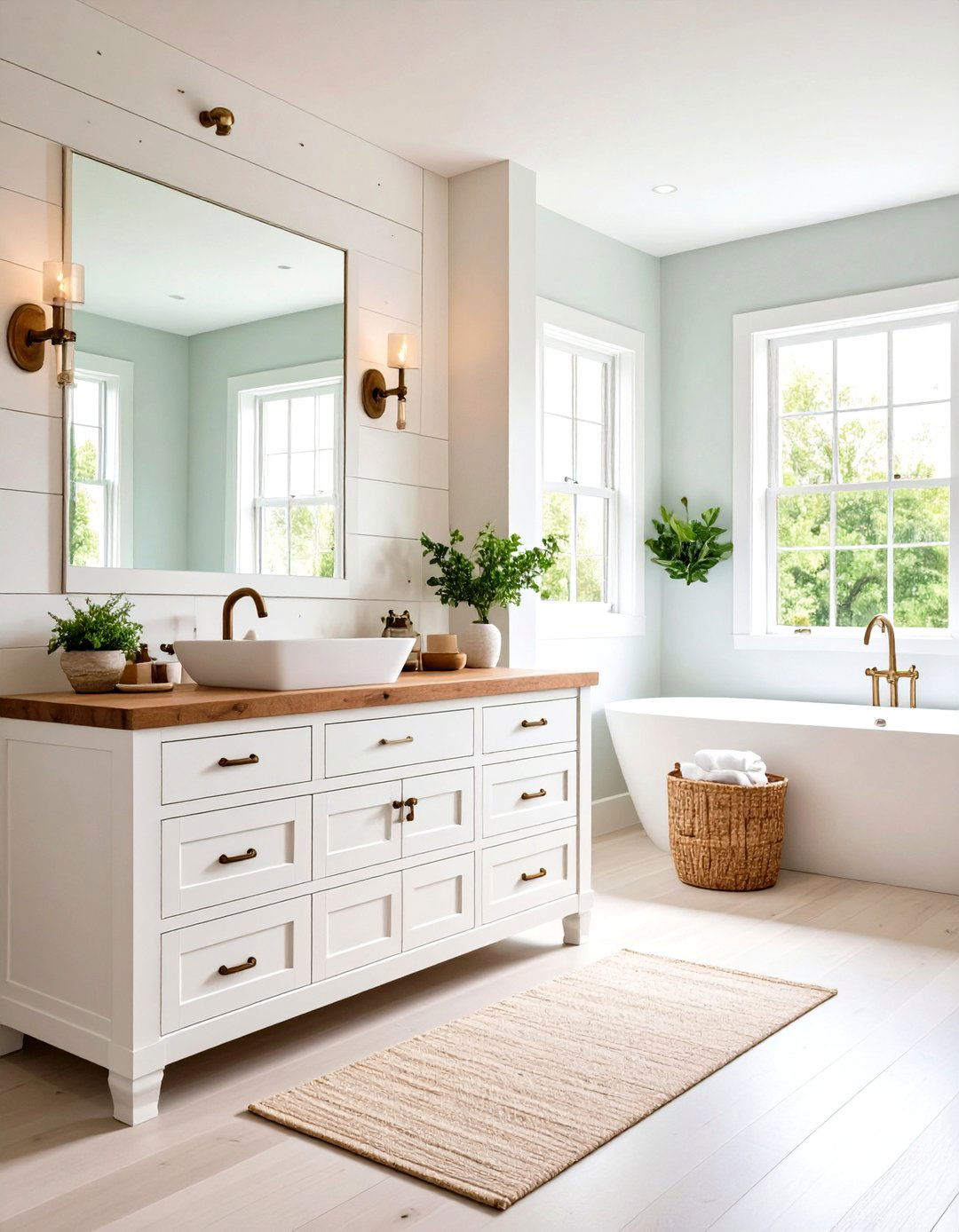
Take cozy country style further with a farmhouse shiplap wood bathroom vanity fronted by horizontal boards painted milky white, then lightly sanded to expose pine knots. The linear siding echoes popular accent walls and offers subtle texture without bulky bevels. Chunky turned legs and cup pulls in aged bronze reinforce the rural mood, while a stained butcher-block countertop injects gentle contrast and can be re-oiled when scratches appear. Designers note that because the basecoat is paint rather than stain, homeowners can easily swap to sage green or powder blue—two colors flagged in current bathroom palettes—without rebuilding the cabinet. Stick-on soft-close dampers will modernize the doors without spoiling the period charm.
8. Japandi Cedar Wood Bathroom Vanity
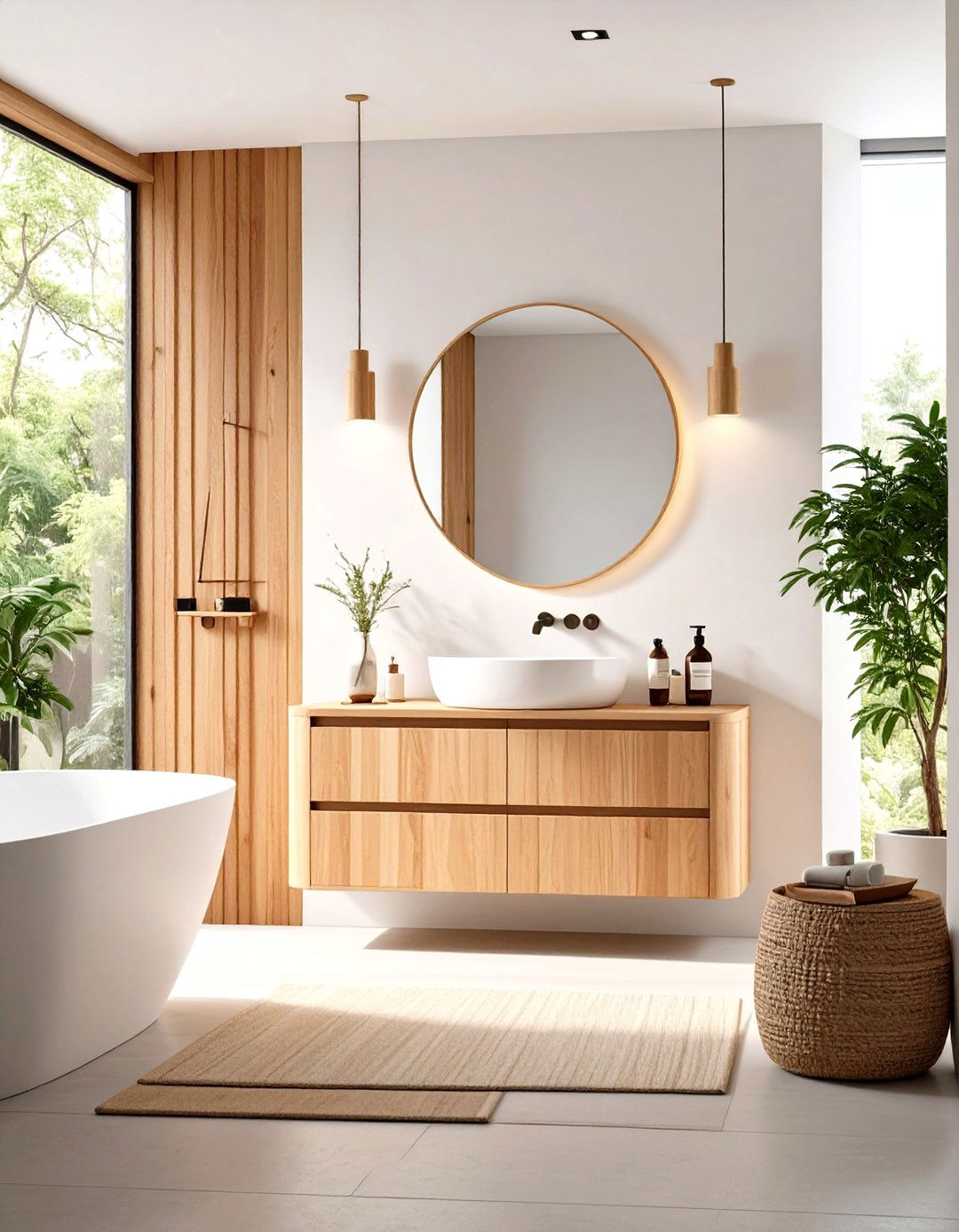
Owing to its straight grain and subtle aroma, a Japandi cedar wood bathroom vanity merges Japanese minimalism with Scandinavian functionality. Builders typically float a slatted cedar box under an ultra-thin porcelain basin, letting elongated vertical lines create calm rhythm and hidden airflow. A matte clear wash keeps the boards pale while resisting humidity, and push-latch fronts avoid visible hardware to maintain serenity. Pair with river-stone accessories and a linen shower curtain for a zen-meets-hygge retreat that still offers discreet drawers for toiletries. Cedar’s lightness also makes wall-mounting safer on older lath walls, and the species’ natural oils help prevent mold growth over time.
9. Modern Teak Wood Bathroom Vanity with Integrated Sink
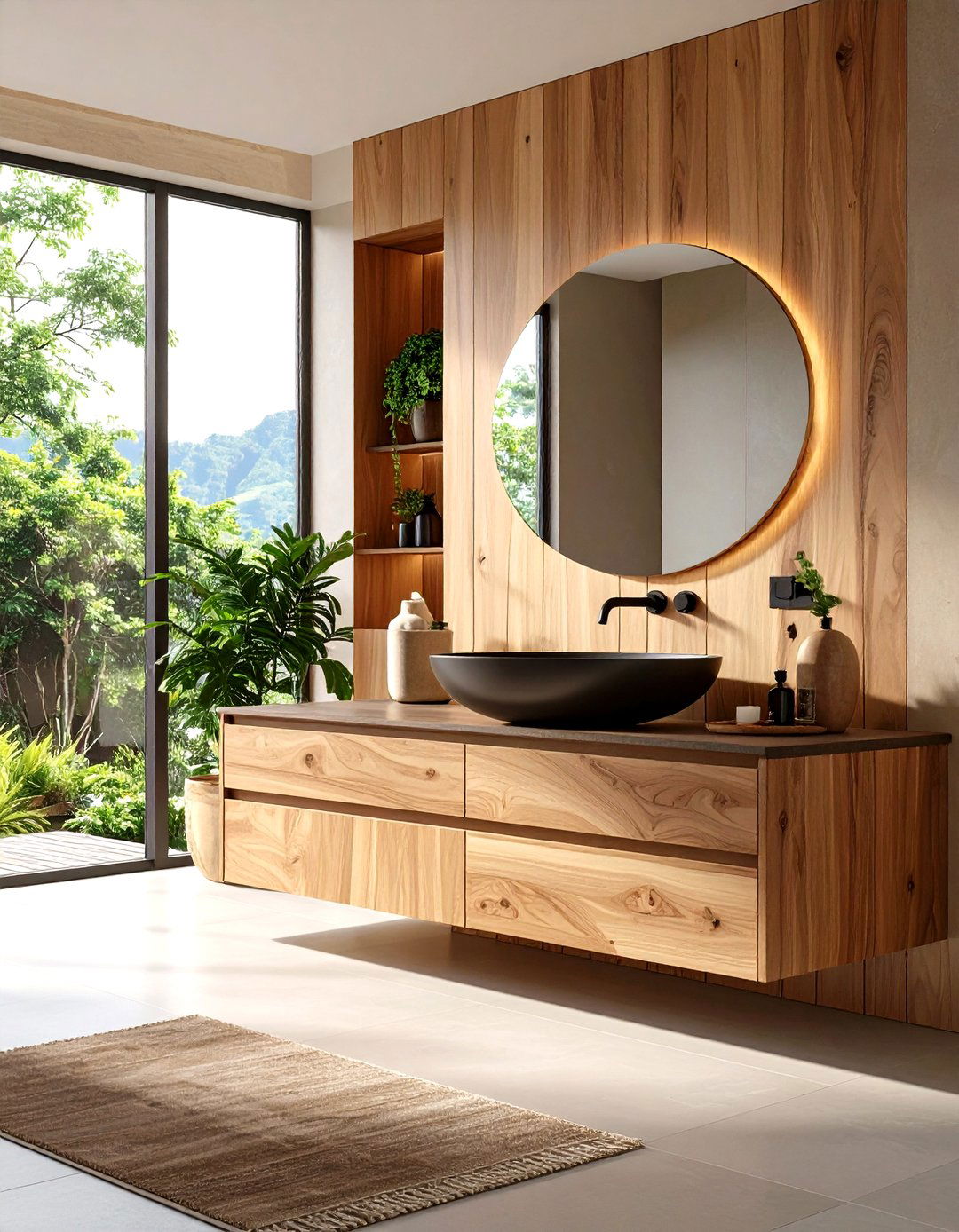
With resorts in Bali as inspiration, a modern teak wood bathroom vanity with an integrated sink mills both basin and countertop from the same water-resistant hardwood, eliminating silicone seams where mildew can hide. Factory-applied marine oil deepens the honey tone and simplifies upkeep—just wipe with a microfiber cloth, no stone sealer required. Because teak moves less than softer species, manufacturers can carve razor-thin edges that read almost like solid surface yet retain organic warmth. Offset the richness with a matte-black wall tap and slatted lower shelf for rolled towels, reinforcing the spa narrative. Teak’s rich silica content means routine soap-and-water cleaning is usually all that’s required.
10. Coastal Whitewashed Wood Bathroom Vanity
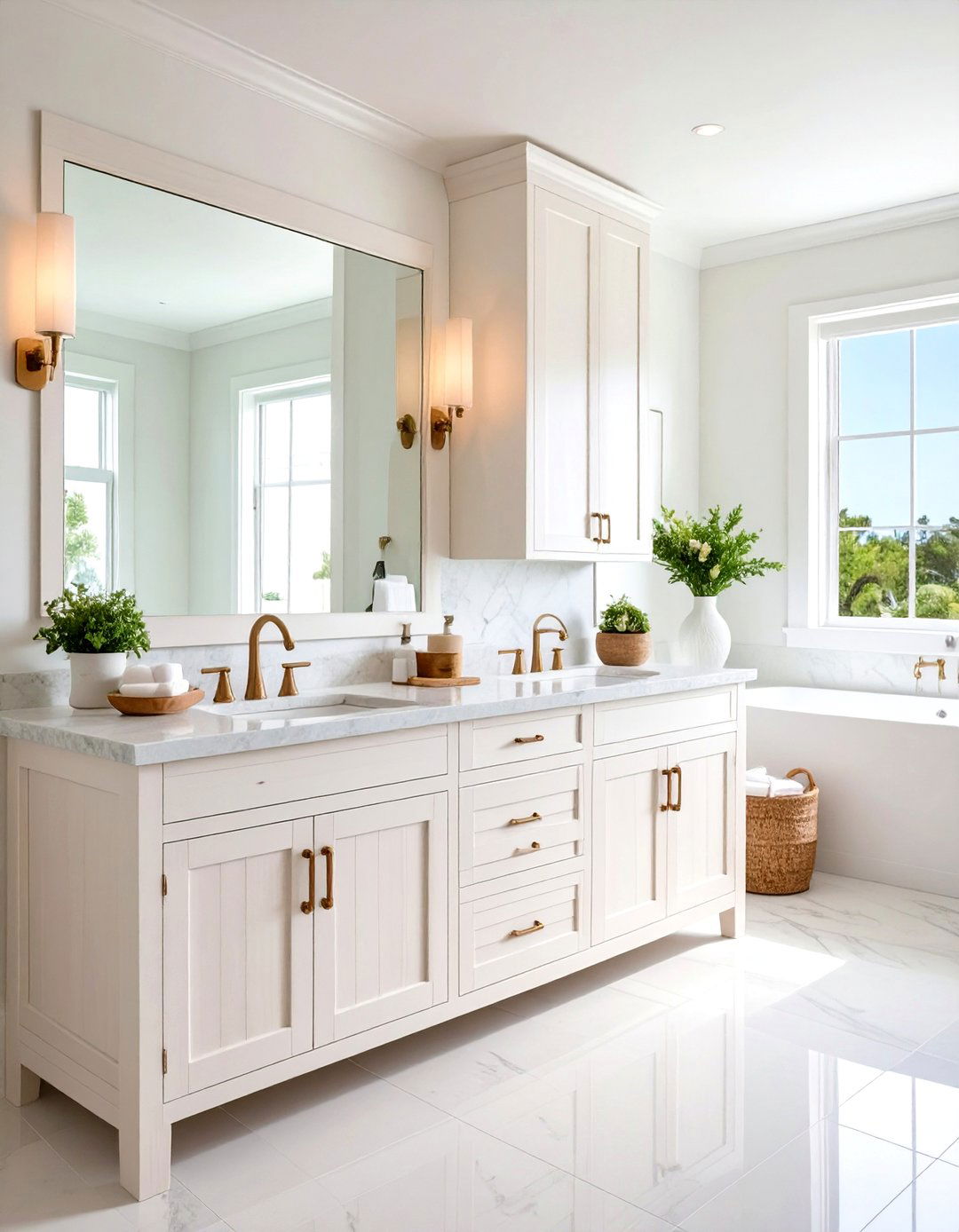
By bleaching out knotty pine and adding a diluted white stain, a coastal whitewashed wood bathroom vanity conjures breezy boardwalk vibes without the maintenance of driftwood. Louvered doors encourage airflow in humid climates, while rope-knot pulls and brass porthole mirrors complete the shoreline story. Designers often upgrade the top to honed Carrara marble; its subtle gray veining accents the pale base and stands up to salty hair-product residue. To prevent yellowing, finish the cabinet with a UV-blocking polyurethane rated for marine use, then style with woven baskets or rolled Turkish towels. Consider cane-front drawers for an extra breathable layer that suits the beach theme.
11. Compact Corner Wood Bathroom Vanity
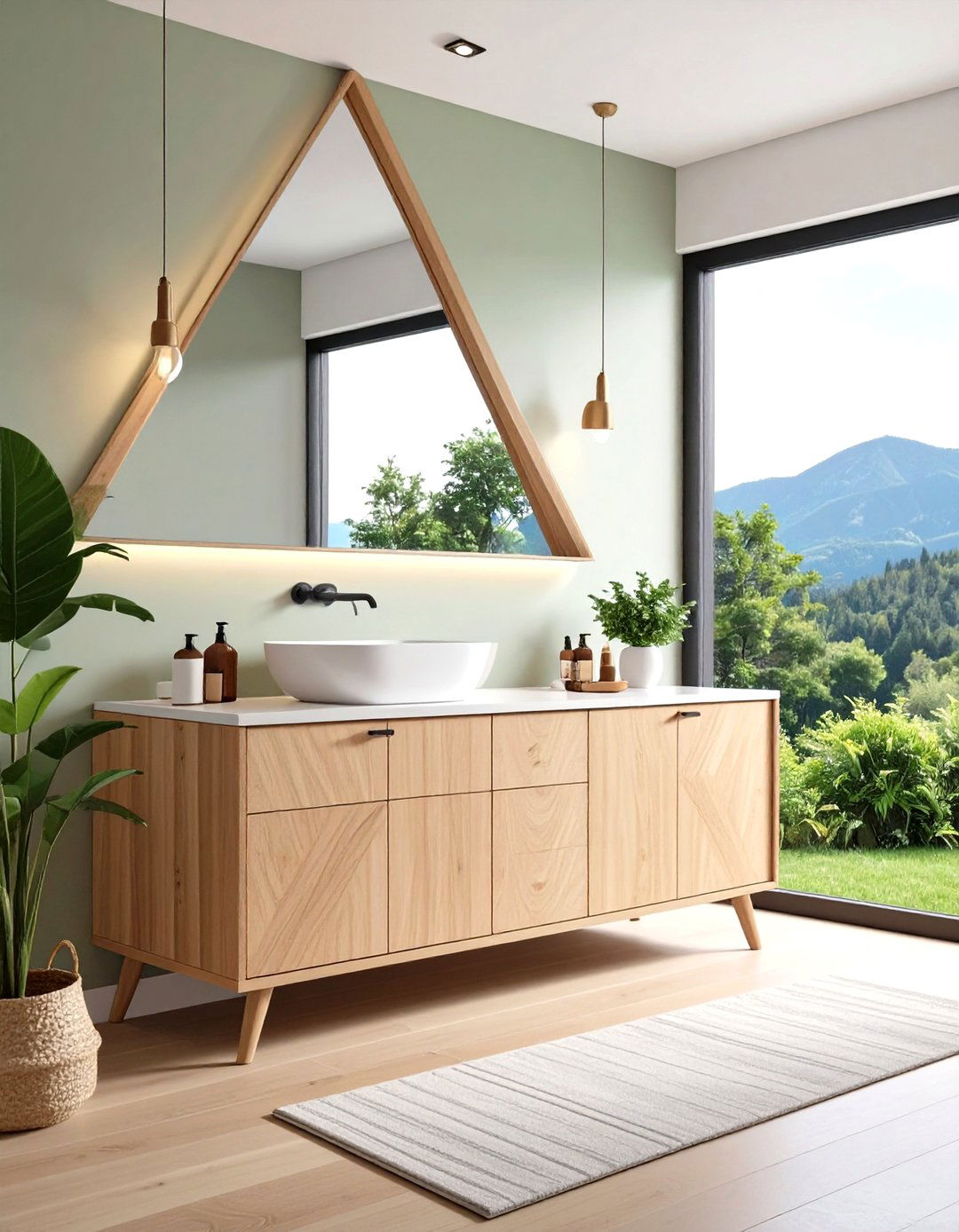
For powder rooms that taper inward, a compact corner wood bathroom vanity turns a forgotten nook into valuable storage without constricting the traffic path. A triangular carcass uses the full depth of the corner, while a curved front avoids sharp points against shins. Hang a slim medicine mirror above and swap sconce placement to the sides to keep profiles shallow. Because only one leg touches each wall, plumbing can snake in behind a removable panel, making service easy. Finish in light maple to reflect scarce daylight and keep the area from feeling cavelike. An open base keeps floor tiles visible, helping the micro-space feel intentionally designed rather than leftover.
12. Double-Sink Distressed Wood Bathroom Vanity

Families with busy mornings applaud the double-sink distressed wood bathroom vanity, which marries vintage texture with maximum elbow room. The cabinet often stretches a full 72 inches, allowing two undermount basins separated by a central bank of drawers that keep grooming tools neatly divided. Skip a full-width mirror and instead hang twin arched frames; the negative space between them lightens the heavy casework and creates symmetry beloved by pros. Wire-brushing and gray-washing the oak surface adds age without sacrificing the dense grain that resists humidity, while soft-close hardware prevents late-night door slams. Installing offset waste lines lets both sinks share one vent stack, saving on plumbing labor.
13. Vintage Dresser-Turned Wood Bathroom Vanity
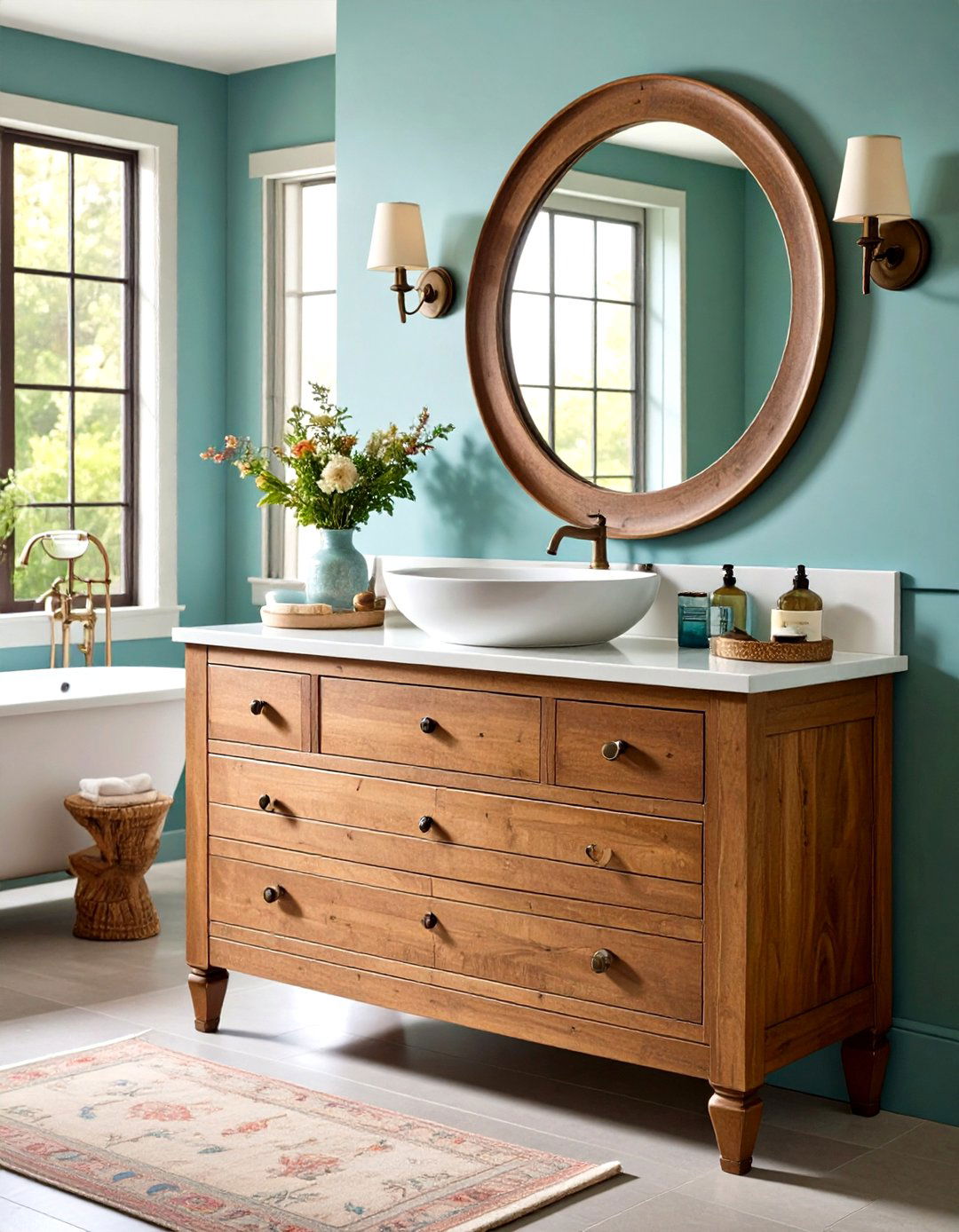
Another budget-friendly route is a vintage dresser-turned wood bathroom vanity, salvaged from estate sales and retrofitted with plumbing. Remove the center drawers, reinforce the frame with pocket screws, and cut a shallow U-shape in the remaining boxes to hide the trap—no carpenter needed. Because the original finish is often shellac, strip and reseal with spar varnish so the piece survives steamy showers. A countertop-mounted vessel sink lets you preserve more drawer depth, while modern bridge faucets ensure water lines clear the drawer tops. A clear glass knob swap delivers subtle sparkle that references vintage perfume bottles and keeps solid hardwood furniture out of landfills.
14. Minimalist Bamboo Wood Bathroom Vanity
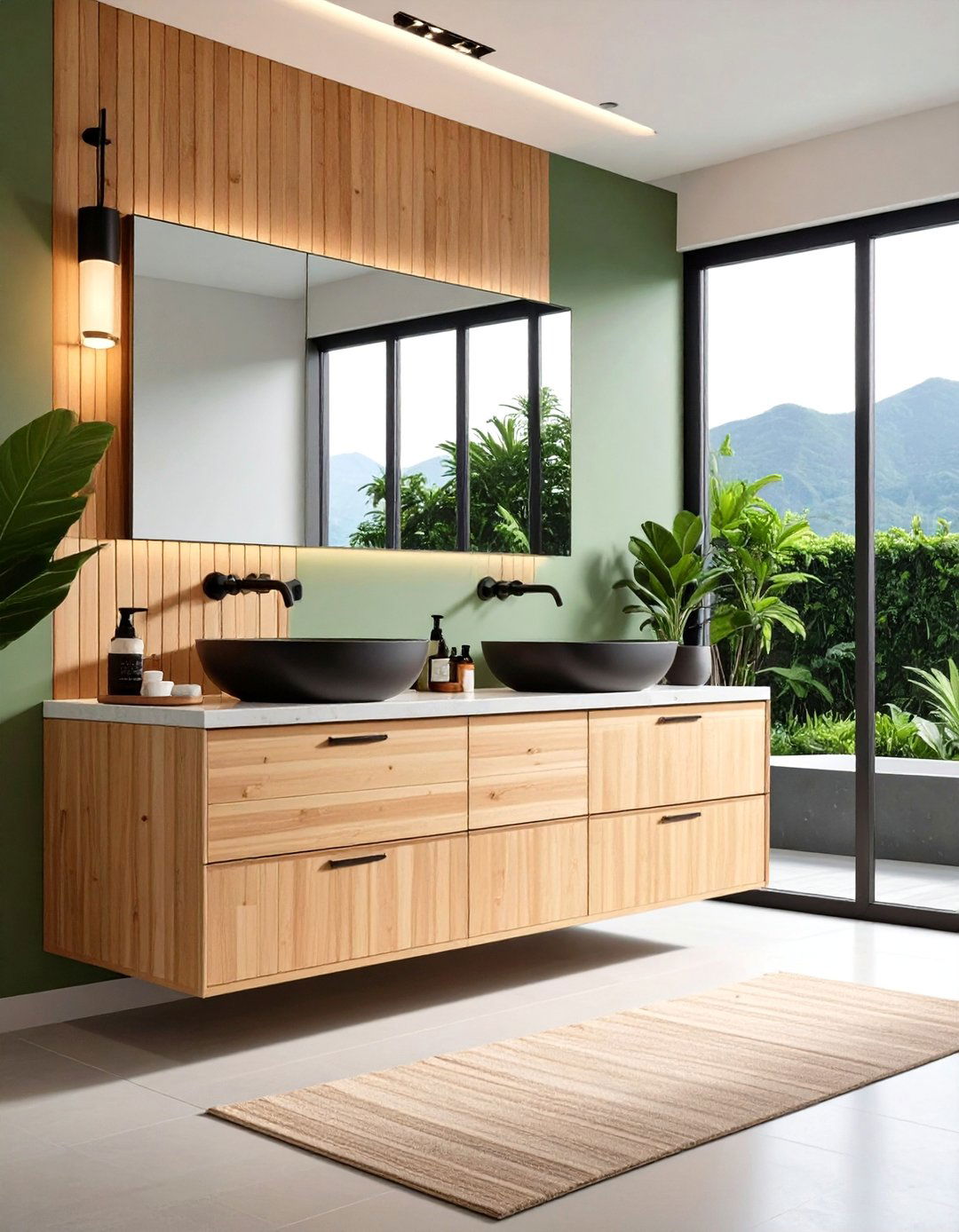
Studies on sustainable design highlight bamboo’s rapid renewability, making a minimalist bamboo wood bathroom vanity an ethical choice that still exudes warmth. Cross-laminated sheets resist swelling better than solid boards, and their tight, linear grain visually widens the room—especially when finished in satin clear coat. Opt for finger-joint drawer fronts to keep the façade hardware-free, then route discreet slot pulls along the top edge for grip. Because bamboo accepts darker stains unevenly, keep the palette blond and let matte-black fixtures provide contrast. A slab quartz sink deck prevents staining from cosmetics and finishes the look with crisp geometry. The grass-like material also sequesters more carbon during growth than slow-grown hardwoods.
Although white continues to dominate, a black-stained wood bathroom vanity delivers boutique-hotel drama, especially when paired with brushed-gold hardware and a ribbed glass divider. Start with ash or oak, whose pronounced pores telegraph through the ebony stain for subtle texture; then seal with a two-part conversion varnish to prevent water spotting. Designers typically counterweight the dark casework with a snowy marble top and high-gloss subway tile, so the scheme feels sophisticated rather than cave-like. Under-cabinet motion lights ensure middle-of-the-night trips remain safe without ruining the moody vibe. Swap standard chrome P-traps for matte-black versions so nothing gleams beneath the dark skirt.
16. Curved Front Artisanal Wood Bathroom Vanity
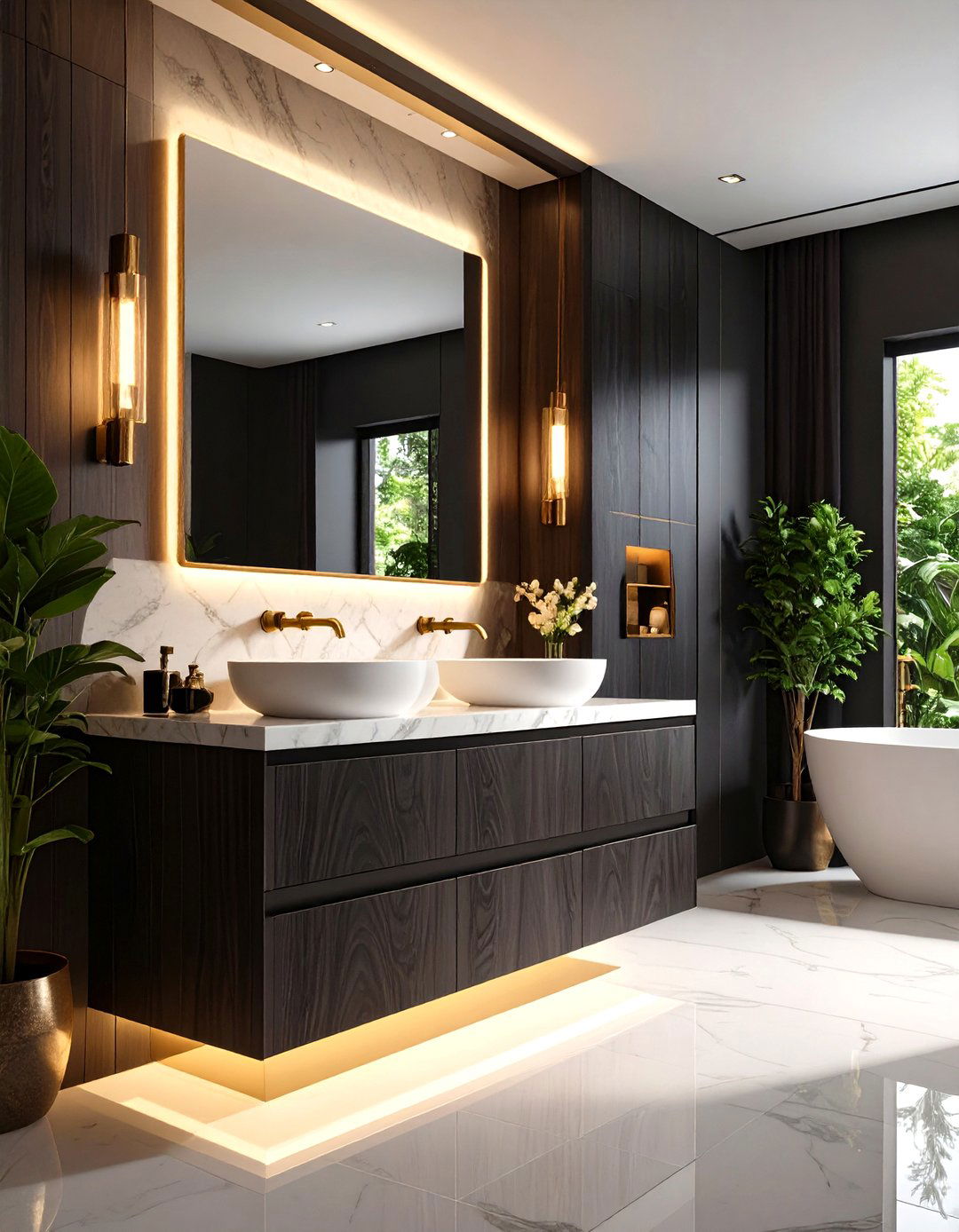
Surprisingly ergonomic, a curved front artisanal wood bathroom vanity softens right angles in a tight bath and helps traffic flow around the sink. Cabinet-makers laminate thin walnut strips over a radiused plywood core, then hand-sand the apron until it feels like a guitar body. The gentle arc gains an extra three inches of toe space without sacrificing storage volume, and finger grooves routed into the underside keep hardware from cluttering the silhouette. Top the piece with an oval undermount basin to echo the curve, and finish in satin oil so light glances dreamily across the grain surface.
Those who prefer grab-and-go storage can opt for an open-shelf wood bathroom vanity that replaces closed cabinetry with a thick slab top perched on box-frame legs and a full-length base shelf. Folded towels, baskets, and spa slippers become part of the décor, encouraging neat habits and quick visual inventory. Use kiln-dried maple for the framing so seasonal humidity changes don’t cause racking, and chamfer the front edges to resist dents. When space allows, roll woven hampers under the shelf to corral laundry; the breathing room helps damp fabrics dry faster and keeps odors down. Finish everything in antimicrobial varnish for hygienic peace of mind.
18. Hidden-Storage Drawer Wood Bathroom Vanity
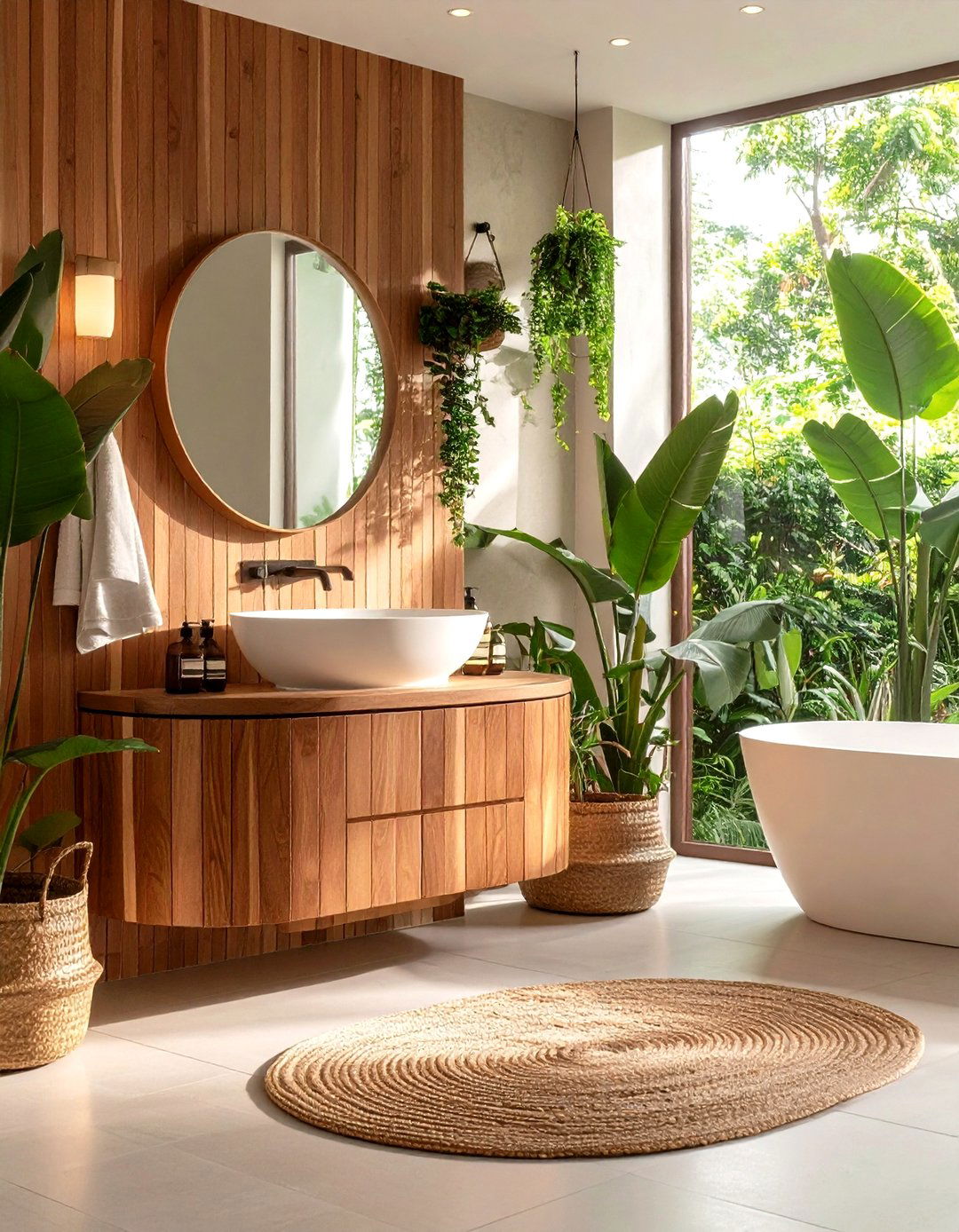
Maximalists hiding their clutter will appreciate a hidden-storage drawer wood bathroom vanity whose shallow top drawers camouflage deeper internal pull-outs behind false fronts. Soft-close hardware lets each nested layer glide silently, and magnetic dividers stop lotion bottles from tipping. Because the drawers ride on full-extension undermount slides, you can reach items at the very back without kneeling. Opt for quarter-sawn white oak; its stability means the narrow reveals stay even, preserving the secret. An undermount sink maintains a clean deck, while a discreet wireless charger powers toothbrushes without visible cords. Integrated LED strips illuminate each cavity the moment you open a panel.
19. Exotic Hardwood Wood Bathroom Vanity
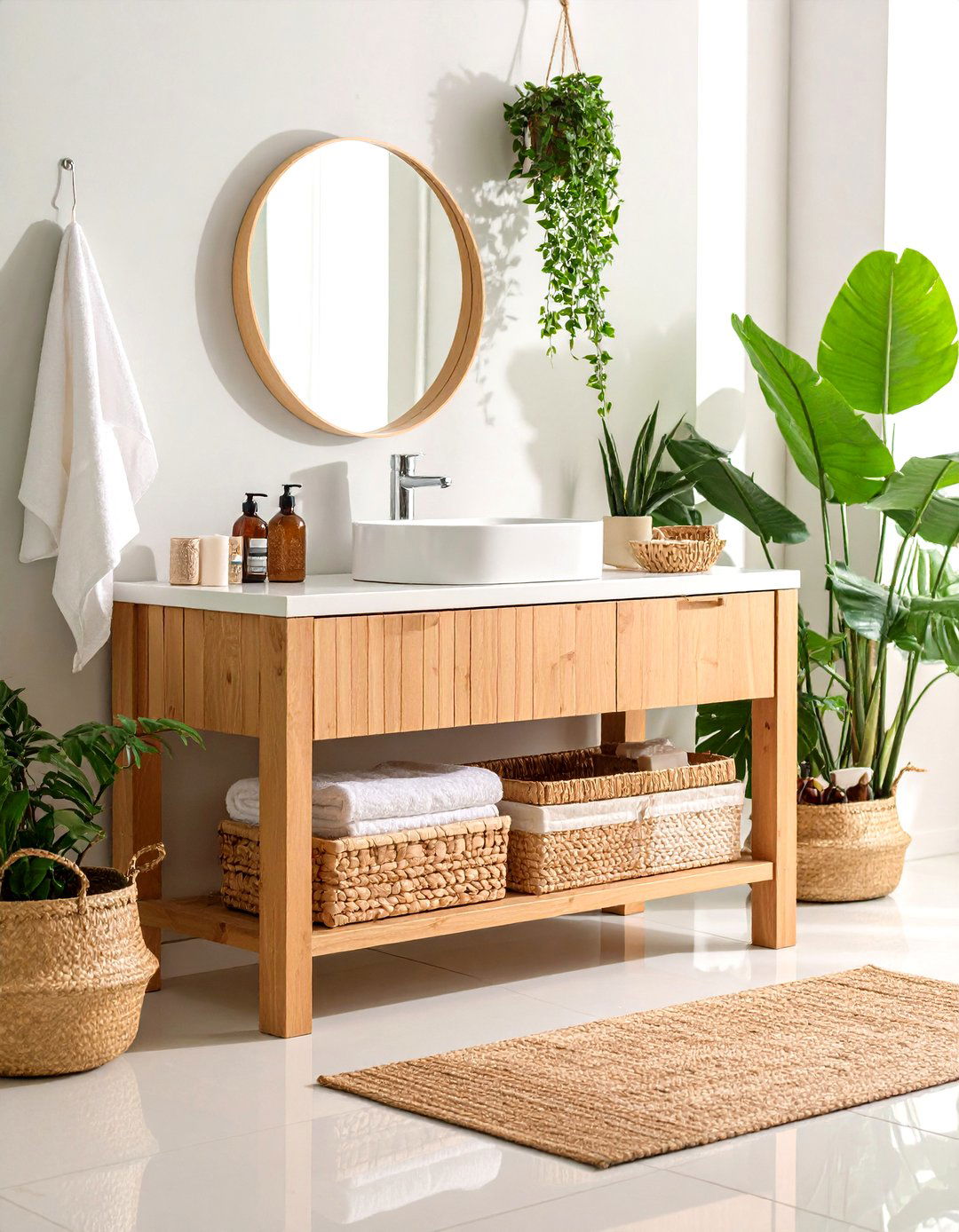
Homeowners craving statement grain might commission an exotic hardwood wood bathroom vanity in iroko or African mahogany, species celebrated for their natural oil content and swirling figure. These timbers shrug off humidity, but their density demands carbide tools and pilot holes when fitting hardware. Offset the bold pattern with minimalist lines: flat-panel doors, slab sides, and a waterfall-edge quartzite countertop. Import certification is vital; look for FSC labeling to ensure responsible harvesting. Finish with a penetrating tung-oil sealer that highlights chatoyance and can be spot-refreshed annually without sanding. Bronze pulls age beautifully alongside the deep reddish tone, eliminating the need for plating.
20. DIY Pallet Wood Bathroom Vanity
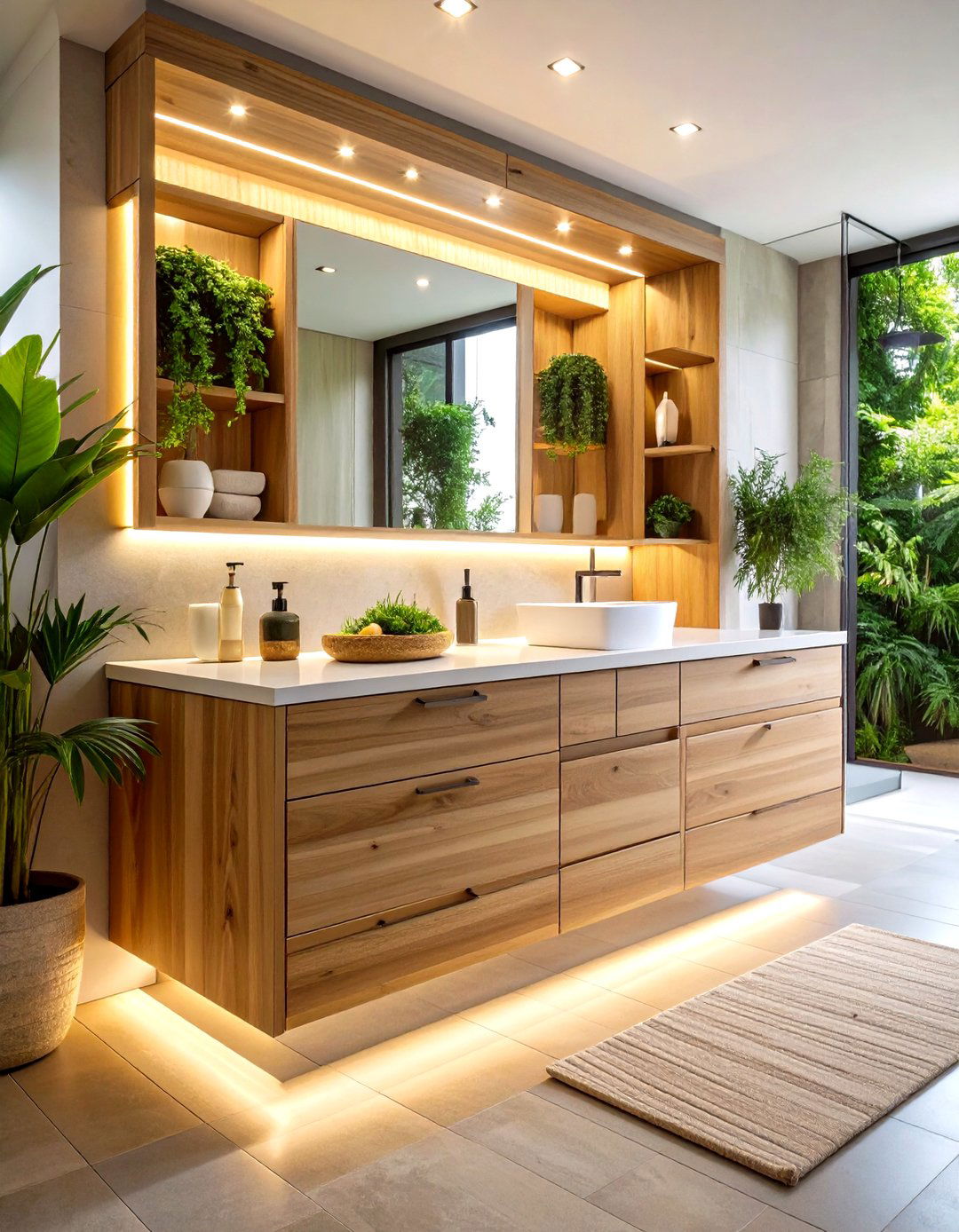
Finally, weekend warriors can tackle a DIY pallet wood bathroom vanity using heat-treated shipping skids disassembled into three-inch planks. After planing off splinters, glue boards into a butcher-block top and frame the base with pocket-screwed rails, leaving deliberate gaps for rustic honesty. Brush on two coats of penetrating epoxy to form a waterproof barrier, then sand to 220-grit and finish with food-safe oil. A drop-in enameled-steel sink installs with minimal routing, and industrial casters make the vanity movable for easy floor cleaning. Reuse leftover pallet slats as matching floating shelves to tie the composition together, and the entire build rarely exceeds $150.
Conclusion:
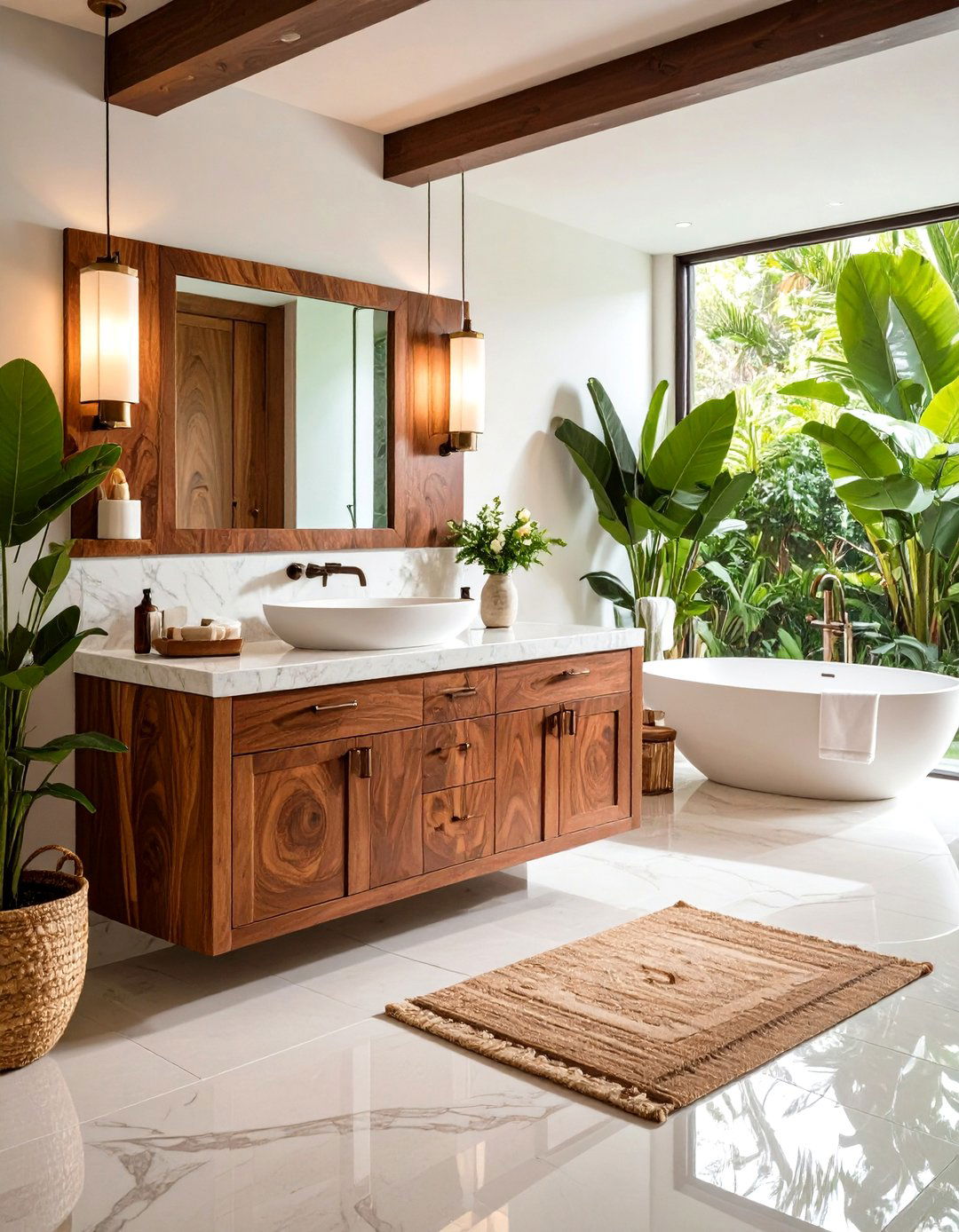
All things considered, these twenty wood bathroom vanity ideas demonstrate the material’s unmatched versatility—from space-saving floating forms to upcycled furniture statements. By selecting the right species, protective finish, and storage strategy, you can align warmth, durability, and personal style in a single hardworking centerpiece. Use the concepts above as a checklist against your own square footage, plumbing position, and aesthetic goals, then choose the wood treatment that delivers both beauty and longevity.





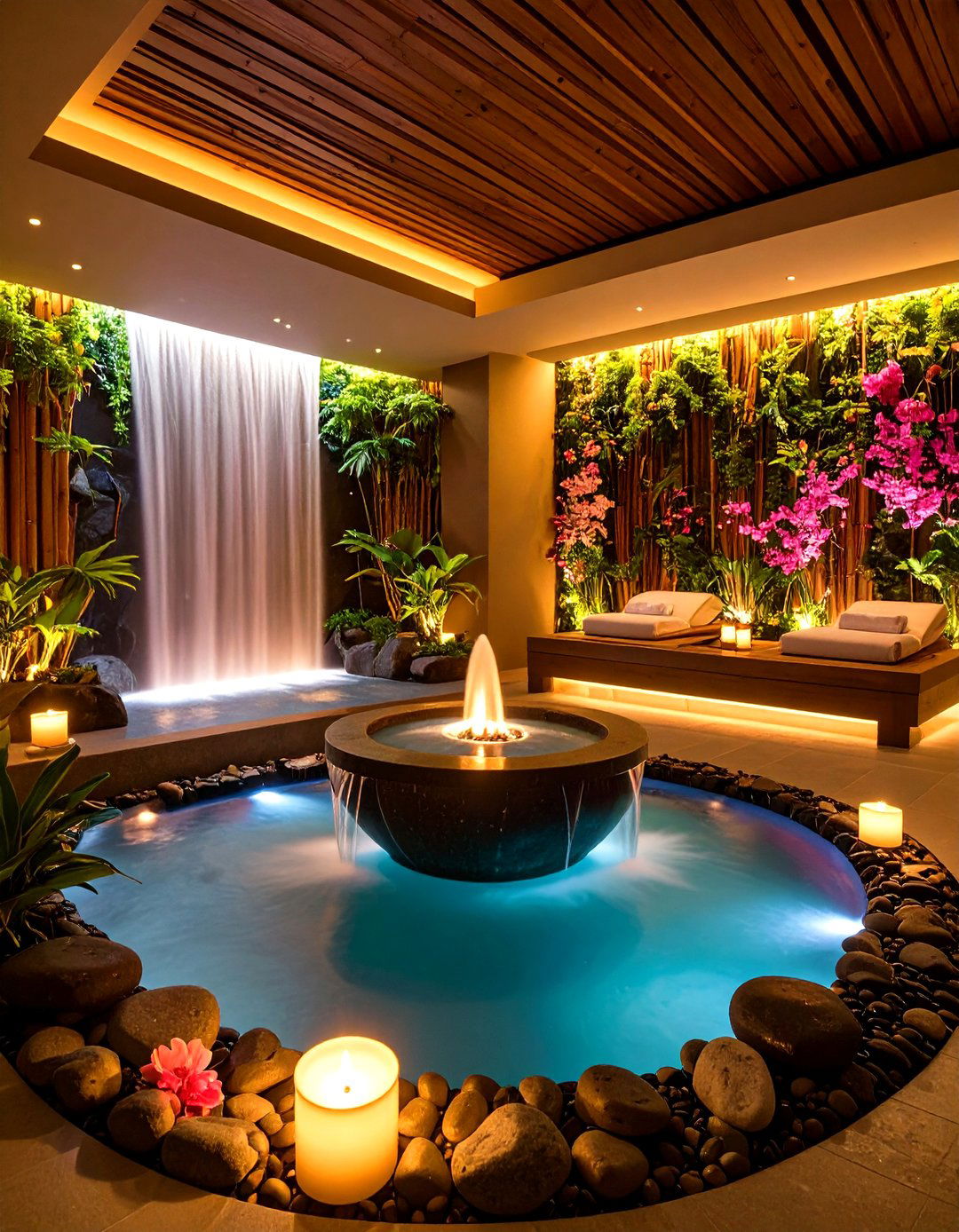
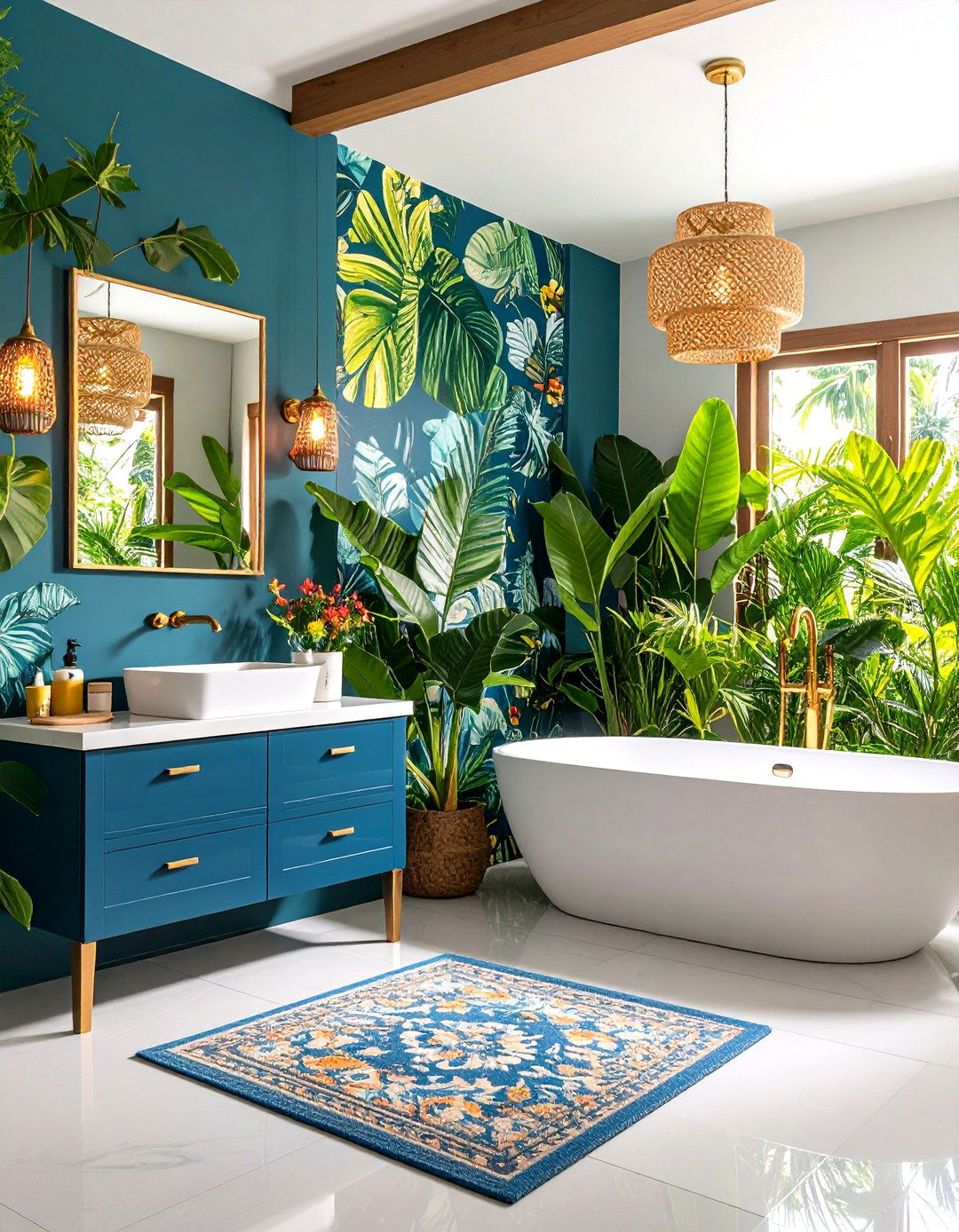
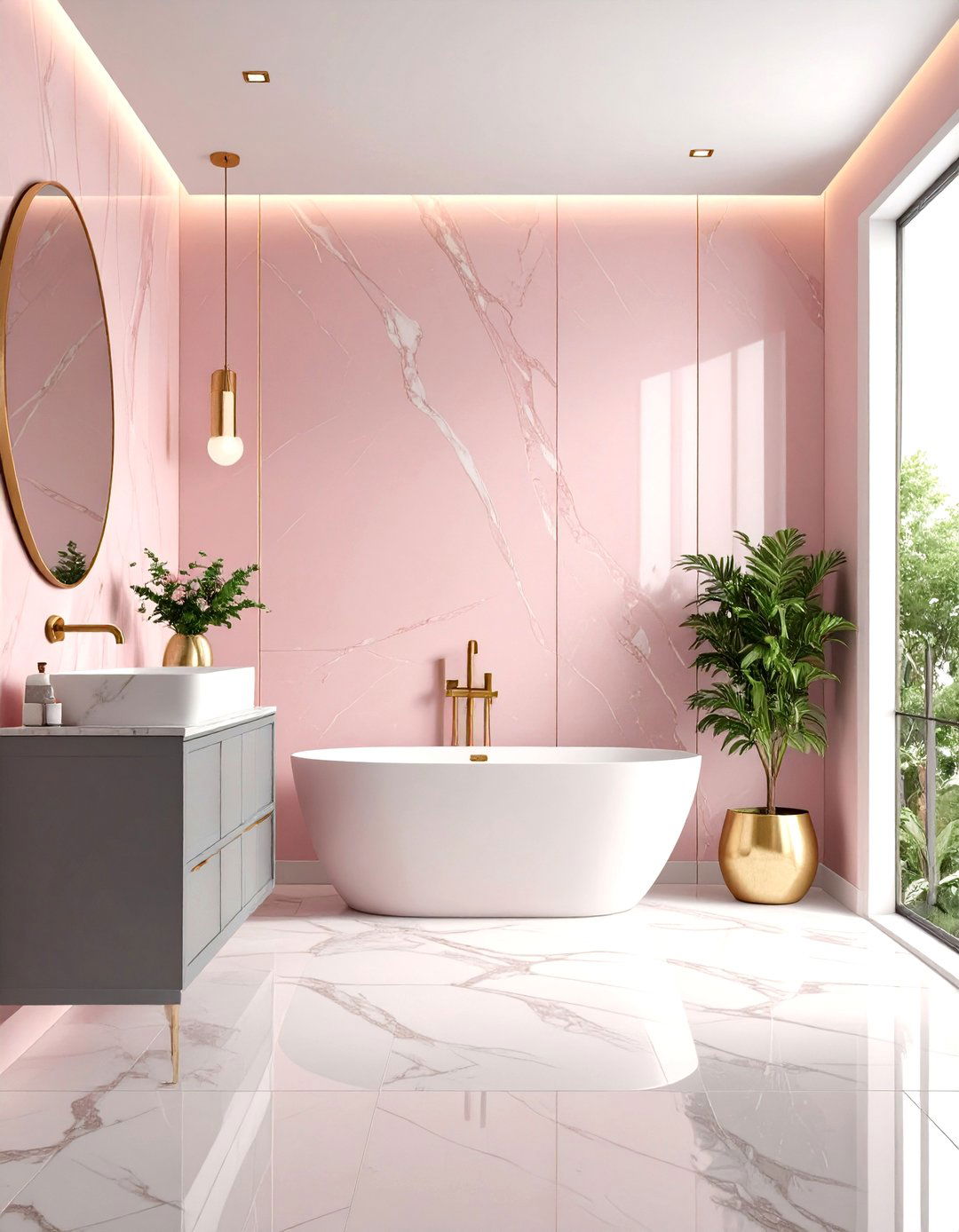
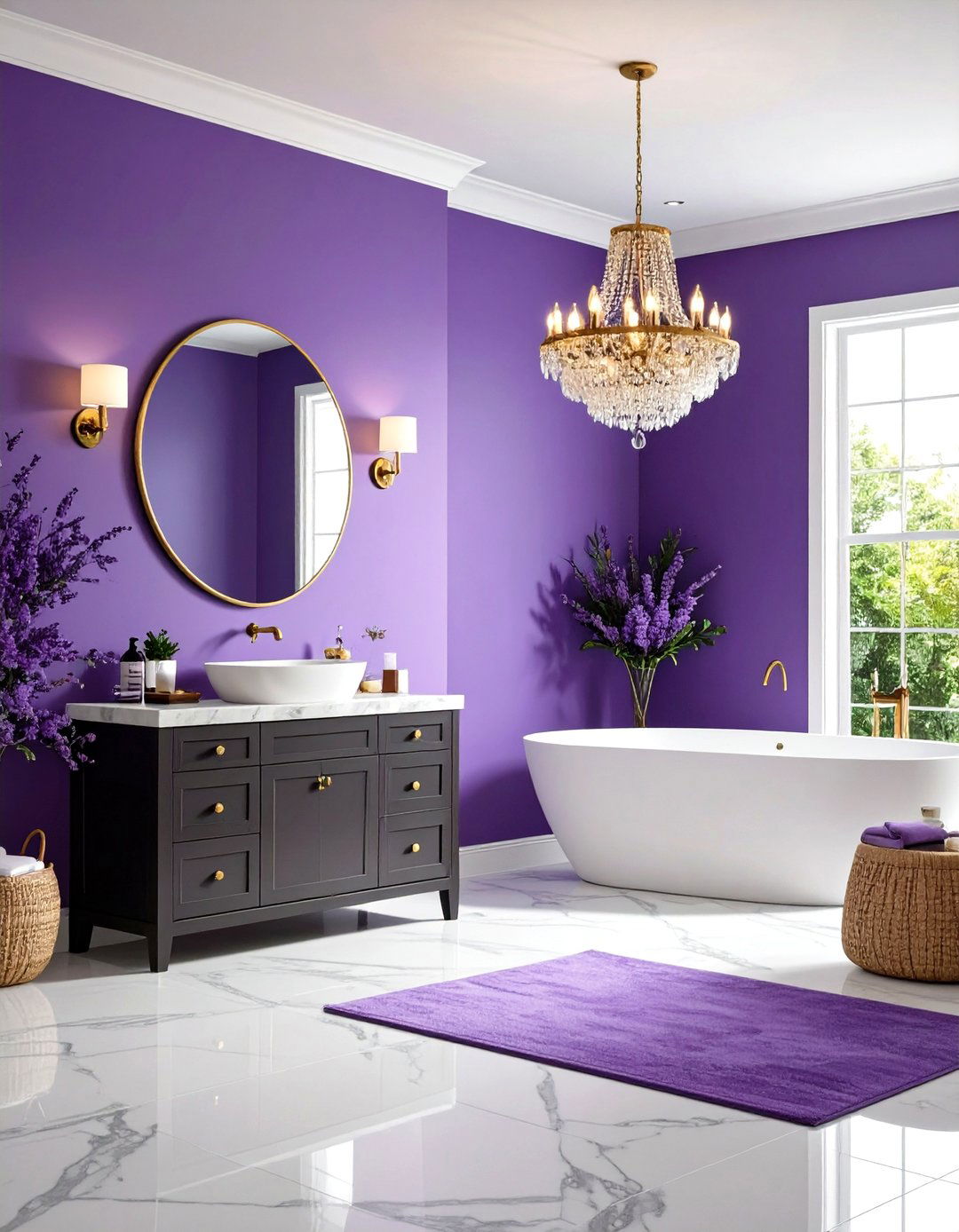
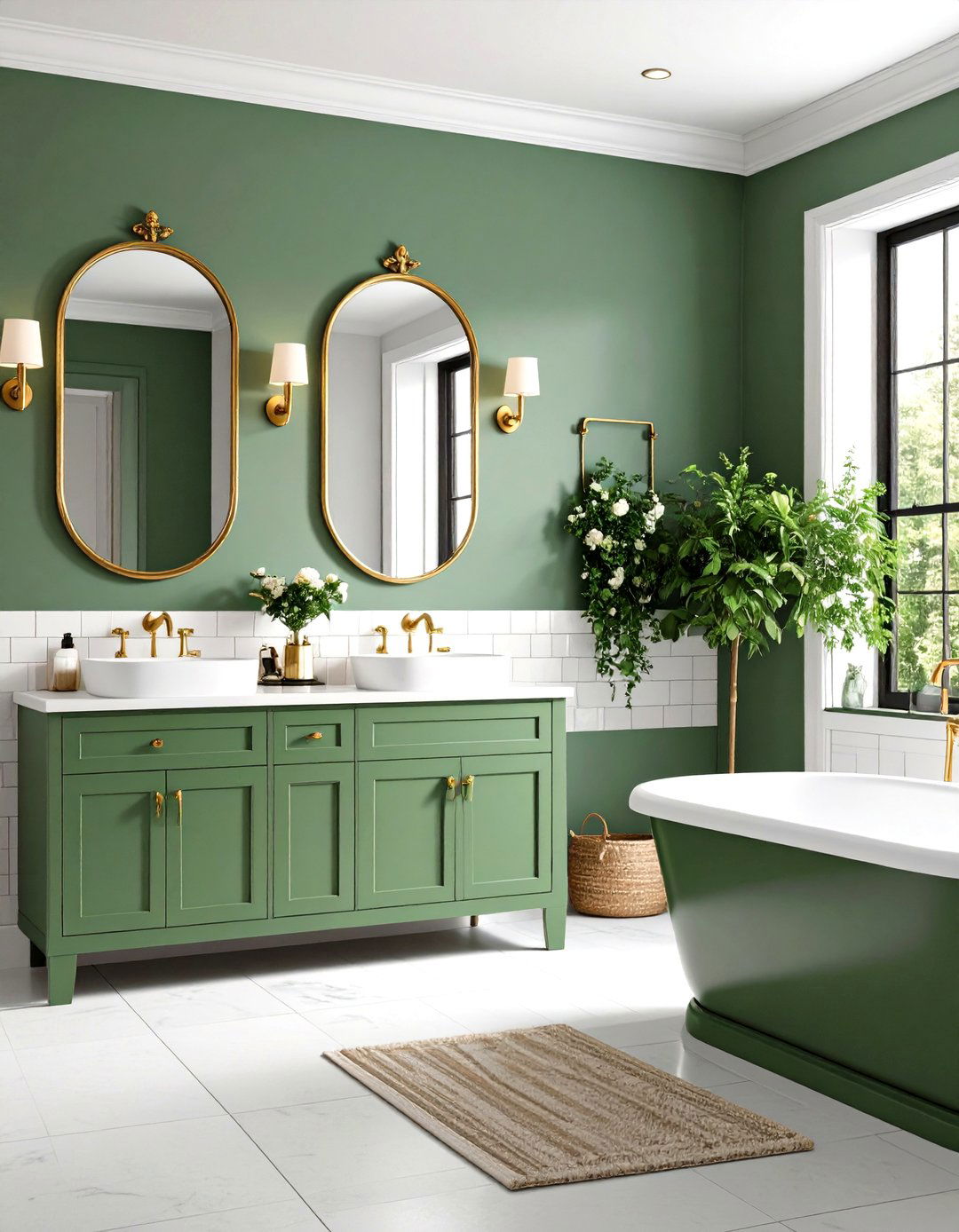
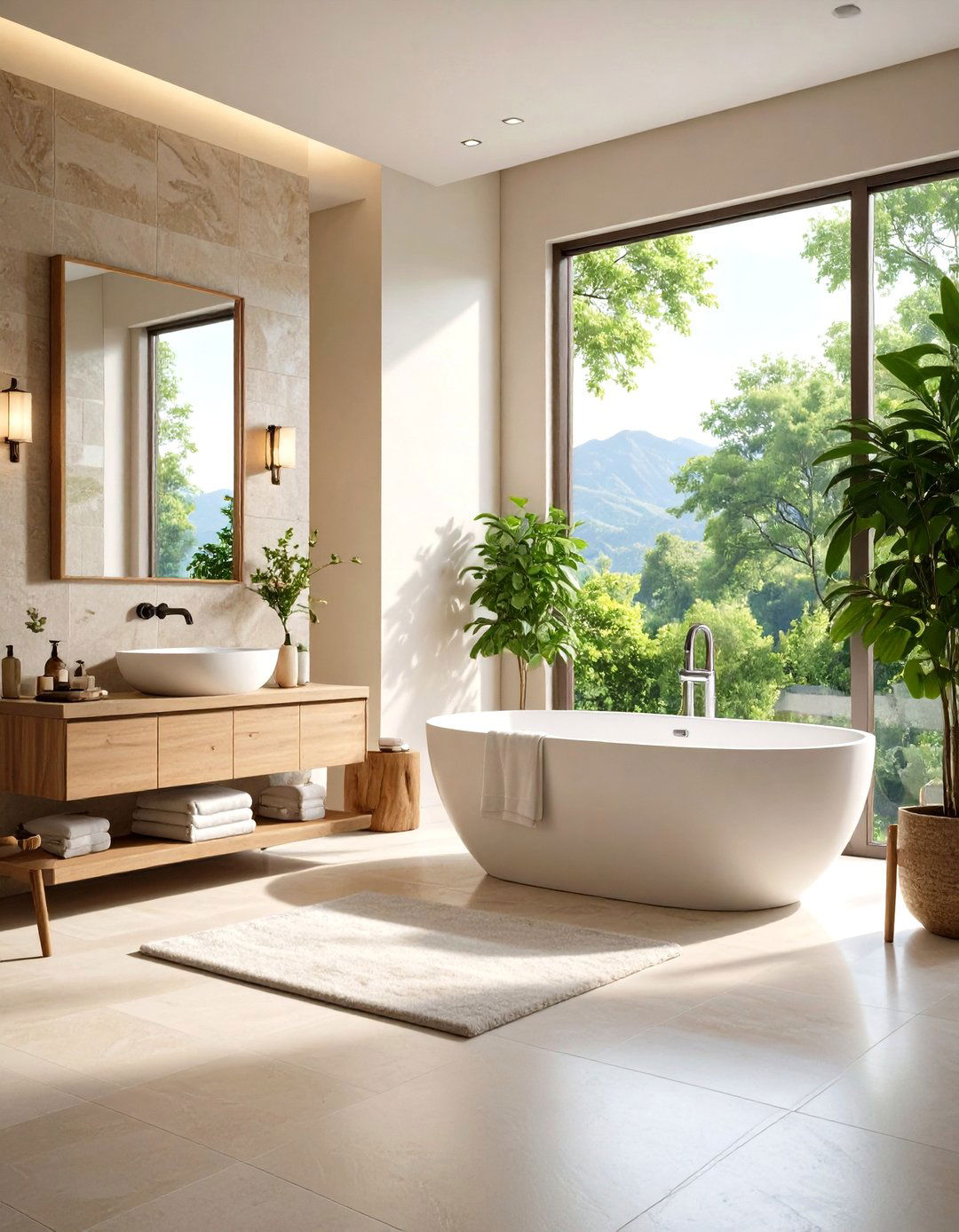
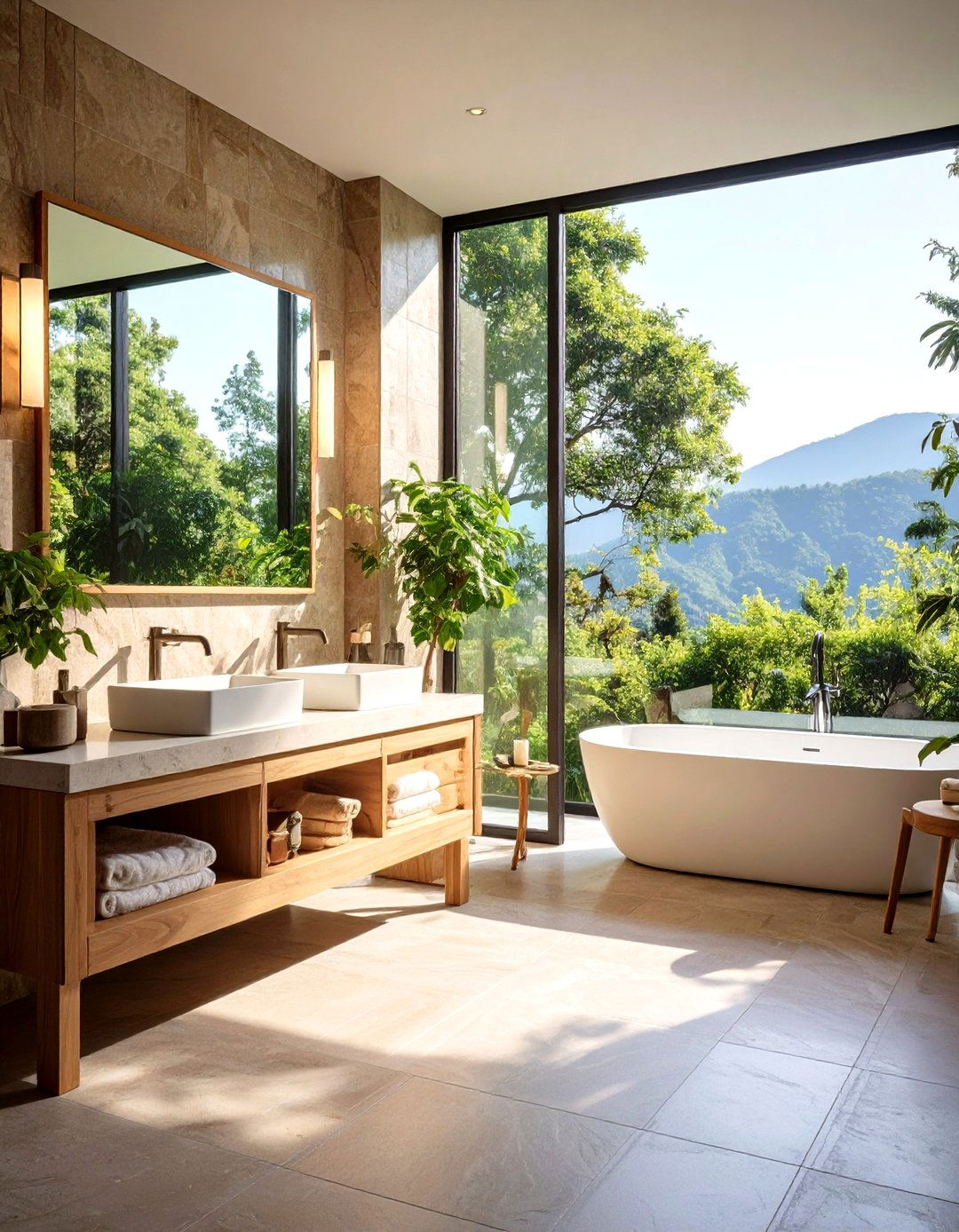
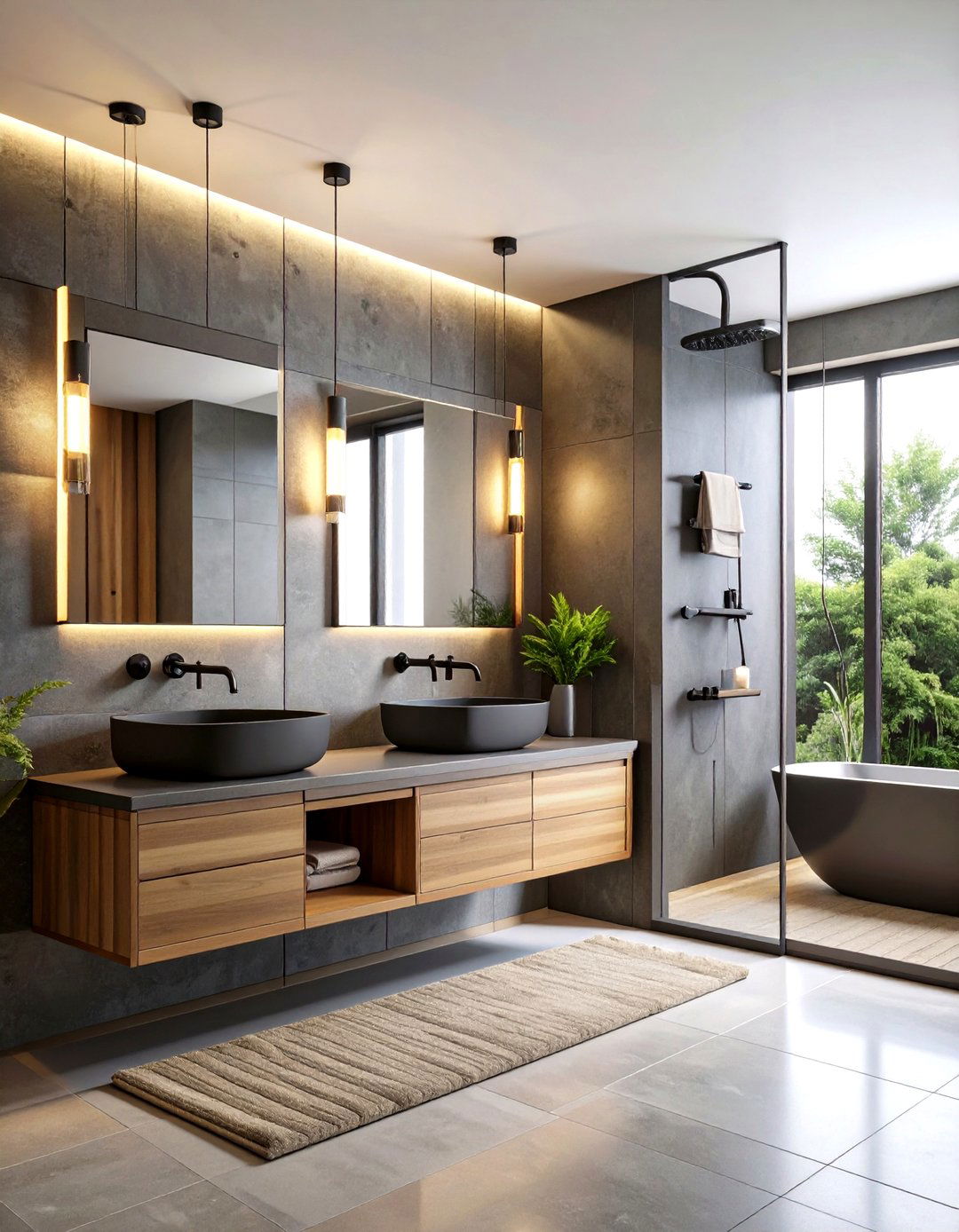
Leave a Reply